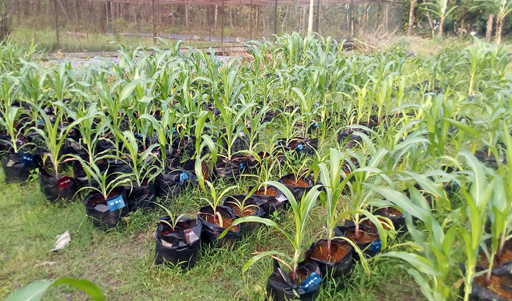
Growth and Yield Response of Maize (Zea mays L.) on Acid Soil to Different Rates of Humic Acid and NPK Fertilizer
Putri Wulandari(1*), Endang Sulistyaningsih(2), Suci Handayani(3), Benito Heru Purwanto(4)
(1) Faculty of Agriculture Universitas Gadjah Mada, Yogyakarta
(2) Faculty of Agriculture Universitas Gadjah Mada, Yogyakarta
(3) Faculty of Agriculture Universitas Gadjah Mada, Yogyakarta
(4) Faculty of Agriculture Universitas Gadjah Mada, Yogyakarta
(*) Corresponding Author
Abstract
The main constraint in the extensification of maize on the dry land of acid soil is the low availability of P in soil. This study aimed to determine the effect and the optimal dose of humic acid on the growth and yield of maize on acid soil. This research was conducted from February to May 2017 at Tri Dharma Field Laboratory, Faculty of Agriculture, Gadjah Mada University. Acid soil with low P availability used was from sub-district Cigudeg and Jasinga, West Java. The research was arranged in Randomized Complete Block Design (RCBD) with 2 factors. The first factor was maize cultivar, namely Bisi 2 and Pioneer 35. The second factor was the rate of humic acid and NPK fertilizer, consisting of 0 kg.ha-1 (without) NPK and 0% (without) humic acid, NPK + 0% (without) humic acid, NPK + 5% humic acid, NPK + 10% humic acid, and NPK + 15% humic acid. NPK fertilizer applied was NPK 16:16:16 at a dose of 350 kg.ha-1. The results showed that humic acid application on acid soil increased C-humic content in the soil, soil P availability, total dry weight of the plant, and kernel dry weight at harvest (15 weeks after planting). The increase in soil P availability did not improve the plant growth but increased the accumulation of plant biomass. The application of humic acid at 15% (52.5 kg.ha-1) combined with NPK fertilizer on acid soil significantly increased total dry weight of plant and kernel dry weight up to 13.14% and 21.81%, respectively, thus, it is recommended for maize cultivation on acid soil.
Keywords
Full Text:
PDFReferences
Badan Penelitian dan Pengembangan Tanaman Pertanian. (2012). Deskripsi varietas unggul jagung. Pusat Penelitian dan Pengembangan Tanaman Pangan Badan Penelitian dan Pengembangan Pertanian Kementerian Pertanian. Maros: Kementerian Pertanian. Retrieved from http://balitsereal.litbang.pertanian.go.id/wp-content/uploads/2016/11/des2012a.pdf
Canellas, L. P., Olivares, F. L., Aguiar, N. O., Jones, D. L., Nebbioso, A., Mazzei, P., & Piccolo, A. (2015). Humic and fulvic acids as biostimulants in horticulture. Scientia Horticulturae, 196, 15–27. https://doi.org/10.1016/j.scienta.2015.09.013
Daur, I., & Bakhashwain, A. A. (2013). Effect of humic acid on growth and quality of maize fodder production. Pakistan Journal of Botany, 45(SPL.ISS), 21–25.
Gardner, F. P., R. B. Pearce, and R. L. Mitchell. 2008. Fisiologi Tanaman Budidaya. Penerjemah Herawati Susilo dan Pendamping Subiyanto. Jakarta: Universitas Indonesia Press.
Haynes, R. J., & Mokolobate, M. S. (2001). Amelioration of Al toxicity and P deficiency in acid soils by additions of organic residues: A critical review of the phenomenon and the mechanisms involved. Nutrient Cycling in Agroecosystems, 59(1), 47–63. https://doi.org/10.1023/A:1009823600950
Hirte, J., Leifeld, J., Abiven, S., & Mayer, J. (2018). Maize and wheat root biomass, vertical distribution, and size class as affected by fertilization intensity in two long-term field trials. Field Crops Research, 216(November 2017), 197–208. https://doi.org/10.1016/j.fcr.2017.11.023
Kementerian Pertanian. (2016). Outlook Komoditas Pertanian Tanaman Pangan Jagung. Jakarta.
Mora, V., Baigorri, R., Bacaicoa, E., Zamarreño, A. M., & García-Mina, J. M. (2012). The humic acid-induced changes in the root concentration of nitric oxide, IAA and ethylene do not explain the changes in root architecture caused by humic acid in cucumber. Environmental and Experimental Botany, 76, 24–32. https://doi.org/10.1016/j.envexpbot.2011.10.001
Mulyani, A., Rachman, A., & Dariah, A. (2009). Penyebaran lahan masam, potensi dan ketersediaannya untuk pengembangan pertanian. Fosfat Alam: Pemanfaatan Pupuk Fosfat Alam Sebagai Sumber Pupuk P.
Rahayuningsih, S. E. A., Indradewa, D., Sulistyaningsih, E., & Maas, A. (2017). The tolerance of photosynthesis of some maize cultivars (Zea mays L.) to waterlogging at different stages of growth. International Journal on Advanced Science, Engineering and Information Technology, 7(4), 1296–1301. https://doi.org/10.18517/ijaseit.7.4.2150
Rivera-Hernández, B., Carrillo-Ávila, E., Obrador-Olán, J. J., Juárez-López, J. F., & Aceves-Navarro, L. A. (2010). Morphological quality of sweet corn (Zea mays L.) ears as response to soil moisture tension and phosphate fertilization in Campeche, Mexico. Agricultural Water Management, 97(9), 1365–1374. https://doi.org/10.1016/j.agwat.2010.04.001
Sajedi, N. A., Ardakani, M. R., Rejali, F., Mohabbati, F., & Miransari, M. (2010). Yield and yield components of hybrid corn (Zea mays L.) as affected by mycorrhizal symbiosis and zinc sulfate under drought stress. Physiology and Molecular Biology of Plants, 16(4), 343–351. https://doi.org/10.1007/s12298-010-0035-5
Sonbai, J. H. H., Prajitno, D., & Syukur, A. (2013). Pertumbuhan dan hasil jagung pada berbagai pemberian pupuk nitrogen di lahan kering regosol. Ilmu Pertanian, 16(1), 77–89.
Suwa, R., Hakata, H., Hara, H., El-Shemy, H. A., Adu-Gyamfi, J. J., Nguyen, N. T., … Fujita, K. (2010). High temperature effects on photosynthate partitioning and sugar metabolism during ear expansion in maize (Zea mays L.) genotypes. Plant Physiology and Biochemistry, 48(2–3), 124–130. https://doi.org/10.1016/j.plaphy.2009.12.010
Suwardi, & Azrai, M. (2013). Pengaruh Cekaman Kekeringan Terhadap Hasil Genotipe Jagung, (Mapegau 2001), 139–147.
Tan, H. . (2003). Humic Matter in Soil and the Environment. CRC press.
Wen, Z., Li, H., Shen, J., & Rengel, Z. (2017). Maize responds to low shoot P concentration by altering root morphology rather than increasing root exudation. Plant and Soil, 416(1–2), 377–389. https://doi.org/10.1007/s11104-017-3214-0
Zhang, W., Liu, D. Y., Li, C., Chen, X. P., & Zou, C. Q. (2017). Accumulation, partitioning, and bioavailability of micronutrients in summer maize as affected by phosphorus supply. European Journal of Agronomy, 86, 48–59. https://doi.org/10.1016/j.eja.2017.03.005
Zhu, J., Li, M., & Whelan, M. (2018). Phosphorus activators contribute to legacy phosphorus availability in agricultural soils: A review. Science of the Total Environment, 612, 522–537. https://doi.org/10.1016/j.scitotenv.2017.08.095
Zubachtirodin, Pabbage, M. S., & Subandi. (2008). Wilayah produksi dan potensi pengembangan jagung. Balai Penelitian Tanaman Serealia, 462–473. Retrieved from http://balitsereal.litbang.pertanian.go.id/wp-content/uploads/2016/11/lima.pdf
Article Metrics
Refbacks
- There are currently no refbacks.
Ilmu Pertanian (Agricultural Science) ISSN 0126-4214 (print), ISSN 2527-7162 (online) is published by Faculty of Agriculture Universitas Gadjah Mada collaboration with Perhimpunan Sarjana Pertanian Indonesia (PISPI) and licensed under a Creative Commons Attribution-ShareAlike 4.0 International License.











_2025_-_kecil_.png)
_2024_kecil_2.png)
